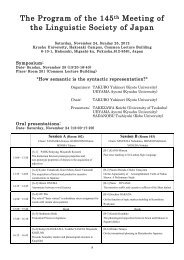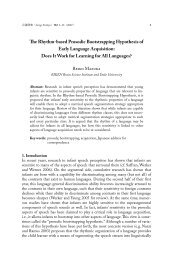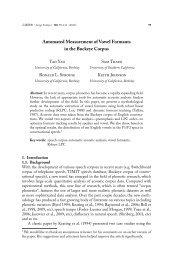第117åæ¥æ¬è§£åå¦ä¼ç·ä¼ã»å ¨å½å¦è¡éä¼ è¬æ¼ããã°ã©ã ã»æé²é PDF ...
第117åæ¥æ¬è§£åå¦ä¼ç·ä¼ã»å ¨å½å¦è¡éä¼ è¬æ¼ããã°ã©ã ã»æé²é PDF ...
第117åæ¥æ¬è§£åå¦ä¼ç·ä¼ã»å ¨å½å¦è¡éä¼ è¬æ¼ããã°ã©ã ã»æé²é PDF ...
Create successful ePaper yourself
Turn your PDF publications into a flip-book with our unique Google optimized e-Paper software.
117 151<br />
P<br />
<br />
<br />
<br />
<br />
<br />
<br />
<br />
<br />
<br />
<br />
<br />
<br />
parvicellular<br />
part of the ventral posterior nucleus of the thalamus VPPC<br />
retrouniens area central medial thalamic nucleusparafascicular<br />
thalamic nucleusparvicellular part of the subparafascicular thalamic nucleus<br />
oval paracentral thalamic nucleus paraventricular thalamic nuclei<br />
rhomboid thalamic nucleus <br />
VPPC<br />
<br />
<br />
P<br />
Classification of rat pallidofugal projection systems revealed by<br />
singleneuron tracing study with a viral vector<br />
1,2 1 1 1 1<br />
1<br />
2 JST, CREST<br />
The main striatofugal system is divided into two neural populations, the<br />
striatonigral neurons striatal direct pathway neurons and the striatopallidal<br />
neurons striatal indirect pathway neurons. However, the striatal direct pathway<br />
neurons also give collaterals in the globus pallidus GPe, which is a relay nucleus<br />
in the indirect pathway of the basal ganglia Kawaguchi et al., 1990; Fujiyama<br />
et al., 2011. We also found the targeted region in GPe were different between<br />
the striatal direct and indirect pathway neurons Fujiyama et al., 2011. Our next<br />
question is whether the GPe neurons located in the different regions targeted<br />
by striatal direct and indirect pathway neurons show the same axonal trajectory<br />
or not. To reveal it, the single GPe neurons in rat were labeled by recombinant<br />
Sindbis virus that is designed to express the membranetargeted green fluorescent<br />
protein. In the present study, we found two types of axonal trajectory of GPe<br />
neurons in the different regions and discuss the possibility that the GPe can be<br />
separated functionally to be involved in the different network of the basal ganglia.<br />
P<br />
A Morphological Analysis of Thalamocortical Axon Fibers of Rat<br />
Posterior Nuclei: A Single Neuron Tracing Study with Viral Vectors<br />
1,2 1 1 1 1 <br />
1,4 3 3 2 1<br />
1<br />
2 <br />
3 4 JST, CREST<br />
The posterior thalamic nuclei POm receives inputs from the spinal cord and<br />
trigeminal nuclei, and projects to the primary somatosensory S1 cortex and other<br />
cortical areas. Although thalamocortical axons of single ventral posterior nuclei<br />
neurons are well known to innervate layer L 4 of the S1 cortex with distinct<br />
columnar organization, those of POm neurons have not been elucidated yet. In<br />
the present study, we investigated complete axonal and dendritic arborizations<br />
of single POm neurons in rats using Sindbis viral vectors. When we divided the<br />
POm into anterior and posterior parts according to calbindin immunoreactivity,<br />
dendrites of posterior POm neurons were wider but less numerous than those<br />
of anterior neurons. More interestingly, axon fibers of anterior POm neurons<br />
were preferentially distributed in L5 of the S1 cortex, whereas those of posterior<br />
neurons were principally spread in L1 with wider and sparser arborization than<br />
those of anterior neurons. These results suggest that the POm is functionally<br />
segregated into anterior and posterior parts, and that the two parts may play<br />
different roles in somatosensory information processing.<br />
P<br />
Morphological analysis of axon collaterals derived from single<br />
corticospinal neurons in subcortical structures<br />
<br />
<br />
The corticospinal tract which conveys the final command for control of voluntary<br />
movement has been known to give axon collaterals to various cortical and<br />
subcortical regions. The target regions thus receive the same information with that<br />
gives rise to muscle actions. To assess the collaterals in the subcortical regions by<br />
a morphological approach, we visualized axons of single corticospinal neurons<br />
by injecting a recombinant sindbis virus expressing membranetargeted GFP into<br />
the pyramidal tract. The labeled cortical neurons were distributed in layer V of<br />
the motor cortex and motorsensory corticesareas FL and HL. The corticospinal<br />
neurons gave multiple axon collaterals to various subcortical structures and<br />
especially sent branches, with high frequency, to the striatum 71%, zona incerta<br />
67%, pontine and reticulotegmental nuclei 100%, which are known to play a<br />
role in control of voluntary movement or gating of peripheral inputs to thalamic<br />
nuclei. These abundant subcortical collaterals suggest that the "copy" of final<br />
motor command from the cortex plays an important role in motor and sensory<br />
processing of the subcortical structures.<br />
P<br />
<br />
<br />
1 2 2 2<br />
1<br />
2 <br />
<br />
MCH<br />
<br />
2VGLUT2<br />
MCH <br />
MCH VGLUT2 <br />
<br />
SD MCH <br />
VGLUT2 mRNA in situ hybridizationISH<br />
MCH <br />
VGLUT2 cRNA <br />
<br />
MCH <br />
VGLUT2 <br />
MCH <br />
MCH VGLUT2 <br />
VGLUT2 <br />
<br />
P<br />
Projections from the amygdaloid anterior basomedial and anterior<br />
cortical nuclei to MCHcontaining hypothalamic neurons of the rat<br />
<br />
Dept. Anat. & Morphol. Neurosci., Shimane Univ. Sch. Med., Izumo, Japan<br />
Melaninconcentrating hormone MCH is involve in the regulation of feeding<br />
behavior, and MCHcontaining neurons are distributed mainly in the lateral<br />
hypothalamus LH. The anterior bosomedial nucleus BMA and anterior cortical<br />
nucleus ACo of the amygdala have been known to project to the LH, and to<br />
form part of a circuit involved in processing olfactory, gustatory and visceral<br />
information related to feeding. However, it is still unknown whether or not MCH<br />
containing LH neurons are under the direct influence of the BMA and ACo. Here<br />
the organization of projections from the BMA and ACo to MCHcontaining LH<br />
neurons was examined and new data were provided as follows: 1 the prominent<br />
overlap of the distribution field of the BMA or ACo fibers and that of the MCH<br />
ir neurons is found in the ventrolateral LH; 2 the BMA and ACo axon terminals<br />
make asymmetrical synapses with MCHir neurons; and 3 most of the BMA and<br />
ACo neurons projecting to the ventrolateral LH are positive for VGLUT2 mRNA.<br />
These data suggest that the BMA and ACo of the amygdala may exert excitatory<br />
influence upon the MCHcontaining LH neurons for the regulation of feeding<br />
behavior.







